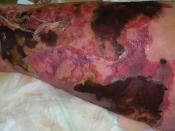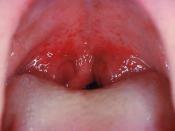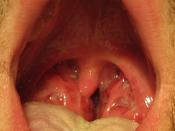The Flesh Eating Bacteria, also known as Necrotizing Fasciitis. This rare disease occurs 90 - 200 times per year in Canada, with a 20-30% fatality rate. This disease was first discovered in 1783, in France. Necrotizing Fasciitis in most cases develops from group A Streptococcus that is commonly found in strep throat.
Causes and Transmission: Many bacteria can cause flesh-eating disease. The most common cause of the flesh eating disease is group A Streptococcus. This is a common bacterium, which causes infections such as strep throat. Ten to fifteen percent of school age children may carry group A Streptococcus in their throat and have no symptoms. It is spread through personal contact with an infected person. For example kissing or sharing cutlery. Group A streptococcus also causes scarlet fever and occasionally causes serious diseases such as pneumonia and Necrotizing Fasciitis. In a serious case, there is rarely a symptom of sore throat.
Group A streptococcus is passed from person to person, Necrotizing Fasciitis can not be passed on.
Patient in coma, after bacteria has "eaten" left upper torso.
Tissue removed, from infected area.
Symptoms: Early Symptoms-Usually occurs within 24 hours. 1.Usually a minor cut or skin irritation. 2.Some pain will occur. Not necessarily at the direct site of the injury but in the general area of the irritation. 3.The pain does have to be related to the irritation but may seem to be a muscle pull or an ache but becomes more painful as it spreads. 4. Flu type symptoms will occur such as nausea, fever, confusion, weakness, dizziness, diarrhea and general depression. 5. Intense dehydration occurs. Regularly you will feel worse than you ever have and not know the reason or understand why.
Advanced Symptoms- Usually occur within 3-4 days. 6. The area with...


